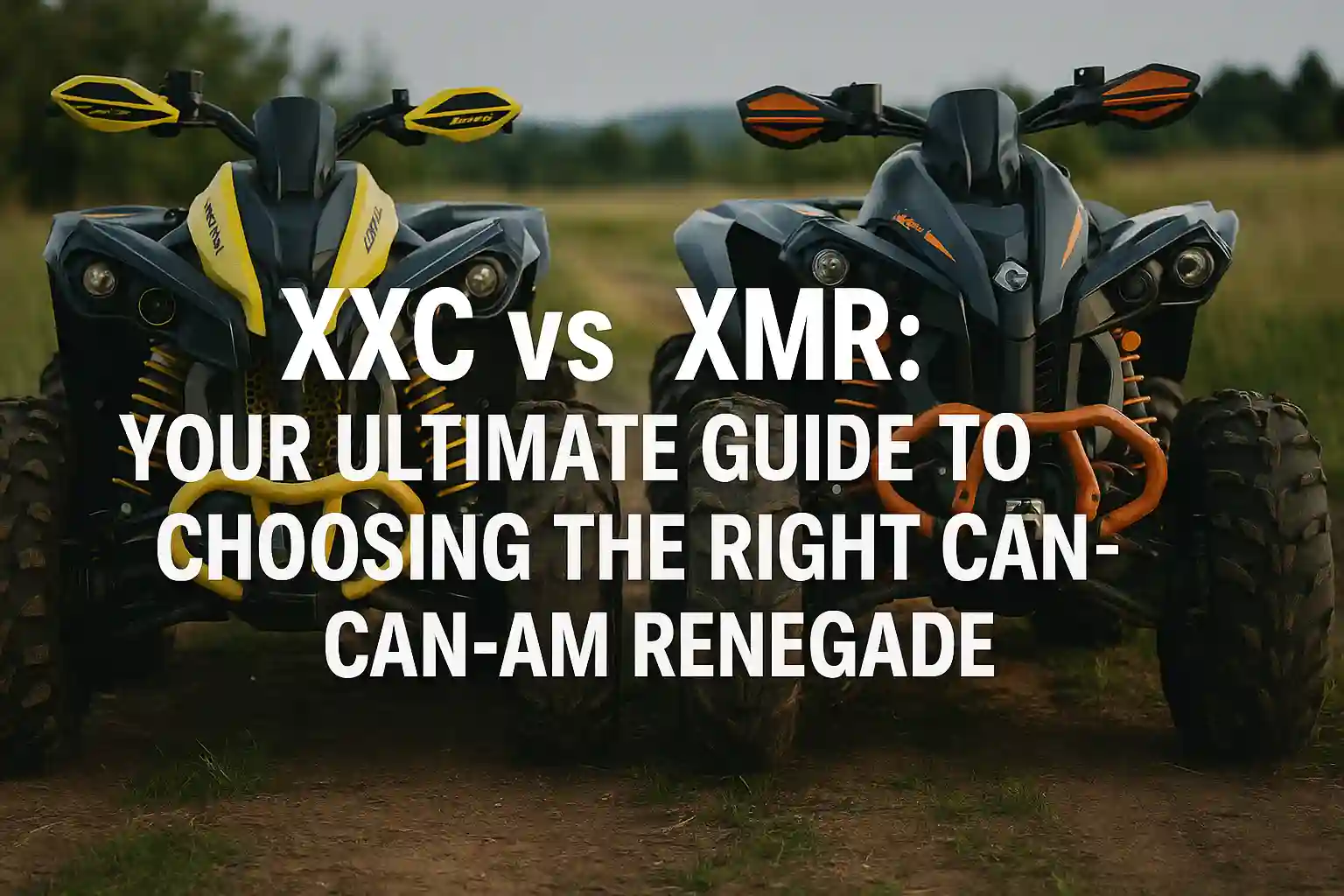
Shopping for an ATV and stuck between the Can-Am Renegade XXC and XMR? You’re not alone. These two beasts dominate the off-road scene, but picking one feels like choosing between a sports car and a monster truck. Both are powerful, fun, and built for adventure, but they’re designed for different thrills. So, how do you decide?
This guide breaks down the XXC vs XMR debate in plain English. We’ll compare their features, performance, and vibes to help you find the perfect ride for your trails—or mud pits—in 2025. Whether you’re a speed junkie, a mud lover, or somewhere in between, you’ll know which Renegade fits your style by the end. Let’s rev up!
What Are the XXC and XMR?
Before diving into the nitty-gritty, let’s get clear on what these ATVs are. The Can-Am Renegade 1000R XXC and XMR are top-tier all-terrain vehicles (ATVs) from Can-Am’s 2025 lineup, each built for specific off-road adventures.
The Renegade XXC: The Trail King
The XXC is made for speed and agility. Think of it as a racecar for trails—light, nimble, and ready to zip through woods, dunes, or rocky paths. It’s perfect for riders who crave high-speed thrills and versatile terrain.
The Renegade XMR: The Mud Master
The XMR is a tank built for the messiest conditions. With beefy tires and mud-ready features, it’s designed to plow through swamps, bogs, and deep muck. If you love getting dirty, this is your ride.
Why Compare Them?
Both share the same 976cc Rotax V-twin engine, pumping out 91 horsepower, but their designs cater to different riders. I once watched a buddy on an XXC fly past me on a trail, while my XMR-owning friend laughed as he pulled through a mud pit I avoided. Your choice depends on where and how you ride.
Key Specs: XXC vs XMR at a Glance
Let’s start with a quick side-by-side look at their specs to set the stage.
| Feature | Renegade 1000R XXC | Renegade 1000R XMR |
|---|---|---|
| Price (2025) | $15,749 | $17,249 |
| Tires | 25 x 8 x 12 in. ITP Holeshot ATR | 30 x 9 x 14 in. ITP Cryptid |
| Ground Clearance | 12 in. (30.5 cm) | 13.5 in. (34.3 cm) |
| Weight | ~850 lbs | ~971 lbs |
| Winch | 3,000-lb WARN | 4,500-lb WARN |
| Differential | Visco-Lok QE auto-locking | Smart-Lok, Visco-4Lok fully lockable |
| Suspension Travel | 9.2 in. front, 9.9 in. rear | 10.5 in. front, 11 in. rear |
| Snorkel System | Optional add-on | Factory-installed |
This table shows the XXC leans light and fast, while the XMR is heavier and tougher. Now, let’s dig deeper.
Performance: How They Ride
Performance is where the XXC vs XMR battle heats up. Both are powered by the same engine, but their tuning and features create different rides.
XXC: Speed and Agility
The XXC’s engine is tuned for quick acceleration and high top speeds—up to 89 mph, per some riders. Its lightweight frame and 25-inch trail tires make it a dream for cornering on hard-packed trails. I rode an XXC on a forest trail once, and it felt like dancing—responsive and smooth over rocks and roots. Its Fox 1.5 PODIUM RC2 shocks soak up bumps, letting you push the pace.
XMR: Torque and Traction
The XMR prioritizes low-end torque, perfect for crawling through mud. Its lower gearing means a top speed around 65–75 mph, but it’s unstoppable in bogs. The 30-inch Cryptid tires dig deep, and the snorkeled airbox keeps the engine breathing in water. A friend’s XMR pulled me out of a swampy mess my dirt bike couldn’t handle—it’s built for that life.
Which Performs Better?
For trails, dunes, or racing, the XXC wins with its speed and handling. For mud, swamps, or extreme off-roading, the XMR’s torque and traction dominate. Your terrain decides the champ.
Design and Features: What Sets Them Apart
The XXC and XMR look similar but pack unique features for their missions. Here’s how they differ.
XXC: Sleek and Sporty
The XXC has a streamlined design with a contoured seat for aggressive riding. Its 12-inch beadlock wheels and sporty Catalyst Gray/Neon Yellow color scream speed. The Visco-Lok QE differential auto-locks for traction, and the 3,000-lb winch is handy for lighter recovery. It’s like a sports bike for dirt—nimble but not mud-optimized.
XMR: Rugged and Ready
The XMR is bulkier, with a rugged look. Its 14-inch beadlock wheels, 30-inch mud tires, and higher ground clearance scream durability. The Smart-Lok differential fully locks for max grip, and the 4,500-lb winch tackles tough pulls. The factory snorkel and relocated radiator let it wade through deep water. I saw an XMR at a mud rally—covered in muck, it still roared.
Comfort and Ergonomics
The XXC’s lower seat and handlebar setup feel connected, reducing fatigue on long trails. The XMR’s higher seat, due to extra clearance, feels less agile but stable in rough stuff. If you’re tall like me (6’2”), the XMR’s roomier stance is comfier for mud slogging.
Read more: How to Use the QY-45Y3-Q8W32 Model: A Comprehensive Guide
Terrain Suitability: Where They Shine
Your riding environment is the biggest factor in choosing between XXC vs XMR. Let’s break it down.
XXC: Versatile Trail Star
The XXC excels on:
- Hard-packed trails
- Rocky paths
- Sand dunes
- Cross-country races
Its lighter weight and tuned suspension make it ideal for varied terrains. It can handle light mud, but deep bogs slow it down. I’ve seen XXCs dominate local trail races, weaving through tight corners with ease.
XMR: Mud and Muck Master
The XMR owns:
- Deep mud pits
- Swamps and marshes
- Water crossings
- Extreme off-road challenges
Its aggressive tires and snorkel system laugh at muddy messes. It’s less nimble on trails, feeling heavy on hard surfaces. At a mud event, I watched an XMR plow through a pit that stopped other ATVs cold.
Crossover Potential
Can the XXC handle mud? With mods like bigger tires and a snorkel, sure—but it’s costly. Can the XMR trail ride? Swap to smaller tires, and it’s decent, but it’ll never match the XXC’s agility. Pick based on your main terrain.
Cost and Value: What’s the Deal?
Money talks. Let’s compare costs and long-term value for XXC vs XMR.
Purchase Price
- XXC: $15,749 (2025 base price)
- XMR: $17,249 (2025 base price)
The XMR’s $1,500 premium covers its winch, snorkel, and beefier components. If you mod an XXC for mud, you could spend $2,000–$3,000, making the XMR a better deal for mudders.
Maintenance and Ownership
The XXC’s lighter design means less wear on parts, but high-speed riding can stress shocks. The XMR’s mud-ready build handles abuse but needs frequent cleaning to avoid corrosion. A buddy with an XMR spends more on maintenance due to muddy rides, but says it’s worth it.
Resale Value
The XXC holds strong resale value due to its broad appeal—trail riders love its versatility. The XMR’s niche mud focus limits buyers but retains value among off-road diehards. Well-maintained models fetch 70–80% of original price after three years, per dealer chats I’ve had.
Read more: Type of FOK959S-M: Exploring Its Variants and Applications
Pros and Cons: XXC vs XMR
Here’s a quick rundown to weigh your options.
Renegade XXC
Pros:
- Lightweight and agile
- Fast top speed (up to 89 mph)
- Great for trails, dunes, and racing
- Lower price
- Better fuel efficiency
Cons:
- Limited mud performance
- Smaller winch (3,000-lb)
- Less ground clearance
Renegade XMR
Pros:
- Unmatched mud performance
- Higher ground clearance
- Stronger winch (4,500-lb)
- Snorkel and lockable differential
- Durable for extreme conditions
Cons:
- Heavier and less nimble
- Higher price
- Lower top speed (65–75 mph)
- More maintenance in mud
Which Should You Choose?
The XXC vs XMR choice boils down to your riding style and terrain. Here’s how to decide.
Pick the XXC If:
- You ride trails, dunes, or rocky paths.
- You love speed and agility.
- You want a versatile, lower-cost ATV.
- Mud is occasional, not your main jam.
Pick the XMR If:
- You live for mud, swamps, or water crossings.
- You need max traction and durability.
- You’re okay with a heavier, pricier ride.
- Trails are secondary to extreme off-roading.
I lean toward the XXC for its all-around fun, but my mud-loving friend swears by his XMR. Test-ride both if you can—dealers often let you try demo models.
FAQs
What’s the Main Difference Between XXC and XMR?
The XXC is built for high-speed trail riding with a lighter frame and smaller tires. The XMR is designed for mud and extreme off-roading with bigger tires, a snorkel, and higher clearance.
Can the XXC Handle Mud?
It can handle light mud, but deep bogs require mods like bigger tires and a snorkel, which add cost. The XMR is better for serious mudding.
Is the XMR Good for Trail Riding?
With trail tires, it’s okay, but its heavier build and lower gearing make it less nimble than the XXC on trails.
Which Has Better Resale Value?
The XXC often retains slightly better value due to its broader appeal, but a well-maintained XMR holds strong in the mud-riding market.
Are Parts Easy to Find for Both?
Yes, Can-Am’s dealer network and aftermarket support make parts for both models widely available.
Conclusion
The Can-Am Renegade XXC vs XMR showdown is all about your adventure style. The XXC is your go-to for zipping through trails with speed and finesse, while the XMR conquers mud pits with raw power. Both are beasts, but your terrain—trails or muck—decides the winner. Which one’s calling your name? Drop your thoughts in the comments, and let’s talk rides! Want more ATV tips? Check out our guides on customizing your Renegade or picking the best off-road gear.





